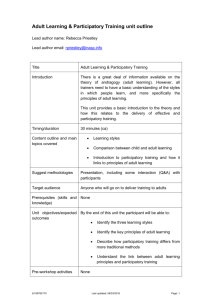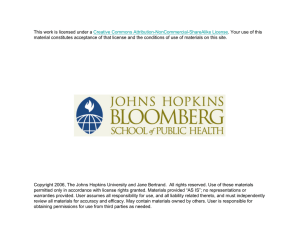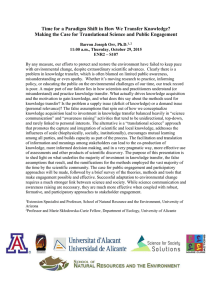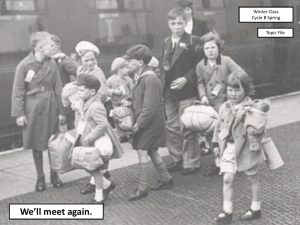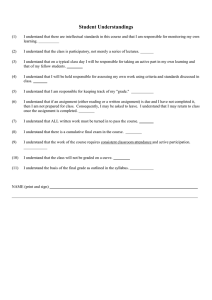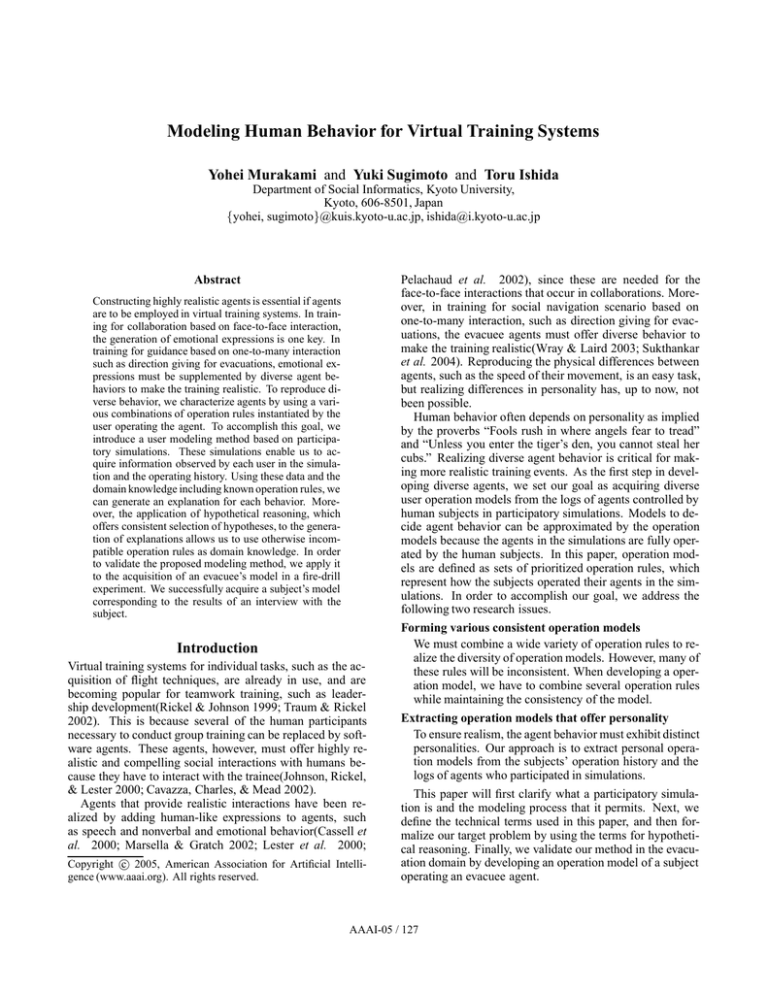
Modeling Human Behavior for Virtual Training Systems
Yohei Murakami and Yuki Sugimoto and Toru Ishida
Department of Social Informatics, Kyoto University,
Kyoto, 606-8501, Japan
{yohei, sugimoto}@kuis.kyoto-u.ac.jp, ishida@i.kyoto-u.ac.jp
Abstract
Constructing highly realistic agents is essential if agents
are to be employed in virtual training systems. In training for collaboration based on face-to-face interaction,
the generation of emotional expressions is one key. In
training for guidance based on one-to-many interaction
such as direction giving for evacuations, emotional expressions must be supplemented by diverse agent behaviors to make the training realistic. To reproduce diverse behavior, we characterize agents by using a various combinations of operation rules instantiated by the
user operating the agent. To accomplish this goal, we
introduce a user modeling method based on participatory simulations. These simulations enable us to acquire information observed by each user in the simulation and the operating history. Using these data and the
domain knowledge including known operation rules, we
can generate an explanation for each behavior. Moreover, the application of hypothetical reasoning, which
offers consistent selection of hypotheses, to the generation of explanations allows us to use otherwise incompatible operation rules as domain knowledge. In order
to validate the proposed modeling method, we apply it
to the acquisition of an evacuee’s model in a fire-drill
experiment. We successfully acquire a subject’s model
corresponding to the results of an interview with the
subject.
Introduction
Virtual training systems for individual tasks, such as the acquisition of flight techniques, are already in use, and are
becoming popular for teamwork training, such as leadership development(Rickel & Johnson 1999; Traum & Rickel
2002). This is because several of the human participants
necessary to conduct group training can be replaced by software agents. These agents, however, must offer highly realistic and compelling social interactions with humans because they have to interact with the trainee(Johnson, Rickel,
& Lester 2000; Cavazza, Charles, & Mead 2002).
Agents that provide realistic interactions have been realized by adding human-like expressions to agents, such
as speech and nonverbal and emotional behavior(Cassell et
al. 2000; Marsella & Gratch 2002; Lester et al. 2000;
c 2005, American Association for Artificial IntelliCopyright gence (www.aaai.org). All rights reserved.
Pelachaud et al. 2002), since these are needed for the
face-to-face interactions that occur in collaborations. Moreover, in training for social navigation scenario based on
one-to-many interaction, such as direction giving for evacuations, the evacuee agents must offer diverse behavior to
make the training realistic(Wray & Laird 2003; Sukthankar
et al. 2004). Reproducing the physical differences between
agents, such as the speed of their movement, is an easy task,
but realizing differences in personality has, up to now, not
been possible.
Human behavior often depends on personality as implied
by the proverbs “Fools rush in where angels fear to tread”
and “Unless you enter the tiger’s den, you cannot steal her
cubs.” Realizing diverse agent behavior is critical for making more realistic training events. As the first step in developing diverse agents, we set our goal as acquiring diverse
user operation models from the logs of agents controlled by
human subjects in participatory simulations. Models to decide agent behavior can be approximated by the operation
models because the agents in the simulations are fully operated by the human subjects. In this paper, operation models are defined as sets of prioritized operation rules, which
represent how the subjects operated their agents in the simulations. In order to accomplish our goal, we address the
following two research issues.
Forming various consistent operation models
We must combine a wide variety of operation rules to realize the diversity of operation models. However, many of
these rules will be inconsistent. When developing a operation model, we have to combine several operation rules
while maintaining the consistency of the model.
Extracting operation models that offer personality
To ensure realism, the agent behavior must exhibit distinct
personalities. Our approach is to extract personal operation models from the subjects’ operation history and the
logs of agents who participated in simulations.
This paper will first clarify what a participatory simulation is and the modeling process that it permits. Next, we
define the technical terms used in this paper, and then formalize our target problem by using the terms for hypothetical reasoning. Finally, we validate our method in the evacuation domain by developing an operation model of a subject
operating an evacuee agent.
AAAI-05 / 127
Subject
Subject
Real Space
Log Data 1. Participatory Simulation
(Coordinate,
Screen Capture of
Operating history…)
Subjects’ Screen
Control
2. Symbolizing Observation
Virtual Space
Agent
Observation
Agent
Agent
Agent
Interaction
Figure 1: Participatory Simulation
3. Interview with Subjects
Domain Knowledge
(Operation Rules)
4. Explanation of Observation
with Hypothetical Reasoning
Explanations of Subject’s Behavior
5. Question and Answer
Operation Model of Subject
Participatory Simulation
A participatory simulation is a multiagent simulation in
which humans control some of the agents. The humans observe the virtual space from the view of their agents, and
operate their agents by using controllers such as keyboards.
The coexistence in virtual space of autonomous agents and
agents controlled by humans can realize indirect interactions
between agents and humans (Figure 1).
The use of participatory simulations in the modeling process brings the following three benefits.
Figure 2: Modeling Process (This paper focuses on the area
in the dotted frame)
• It enables us to extract observations of each human subject and their operation history from the log data.
Definition of Technical Terms
• It enables us to capture a subject’s screen, which is then
shown to the subject at the interview stage to acquire
his/her operation rules effectively.
• It enables us to employ scenario-controlled agents in order to compensate for the lack of participants.
In this research, we acquire a subject’s operation model,
a set of operation rules, by explaining the subject’s behavior
observed in one or more participatory simulations. However,
the operation rules so gained may exhibit some incompatibility. Therefore, we hypothesize whether each operation
rule is employed by the target subject, and choose the assumptions that pass hypothetical reasoning, which offers the
consistent selection of hypotheses. The result of hypothetical reasoning is a set of compatible operation rules employed
by the target subject. We propose the following modeling
process (Figure 2).
1. Conduct participatory simulations with agents controlled
by human subjects.
2. Obtain a target subject’s behavior from log data consisting
of coordinate values and orientation of his/her agent, and
describe the observations in predicate logic.
3. Collect operation rules constituting domain knowledge
through interviews with some of the human subjects.
4. Generate explanations of the target subject’s behavior by
using the domain knowledge and the observations.
5. Winnow the explanations generated in the previous step
by questioning the target subject. The hypotheses in the
last explanation represent the subject’s operation model.
In this paper, we focus on using hypothetical reasoning to
acquire the operation models shown in the dotted frame.
Formalizing the Problem
In this section, to permit the application of hypothetical reasoning to the acquisition of subject operation models, we
formally define the domain knowledge and observations.
In this research, we assume that a subject decides his/her
next operation based on the world as observed from the view
of his/her agent, and his/her operation model. The world observed by the subject is indicated by S. S consists of conjunctions of literals about the world. We describe this piece
of information at time t as S t . Time is a discrete value incremented by one as the world observed by the subject changes.
The operation model is a set of prioritized operation rules
P, . P is a set of operation rules that could be employed
by the subject, and represents the priorities of the elements of P . P is a subset of Rules, a set of operation rules
obtained through interviews with subjects. is a subset of
the Cartesian product Rules × Rules. If each operation rule
in Rules is indicated by rule i (0 ≤ i ≤ j ≤ |Rules|),
rulei , rulej ∈ can be described as rulei rulej .
For applying hypothetical reasoning to the modeling of
subjects, we define an operation selection mechanism and
operation rules as domain knowledge Σ. Each element
of domain knowledge is indicated by σ k (0 ≤ k ≤
|Σ|). We hypothesize which operation rules are employed
by the target subject(rule i ∈ P ), and which rules take
priority(rule i rulej ). A set of these hypotheses, an inconsistent set of assumptions, is indicated by H. Moreover,
we describe the subject’s behavior from the beginning of the
participatory simulation, 0, to the end of the simulation, end,
as observation G. The solution h of hypothetical reasoning
represents the an operation model of the subject. In addition,
h is a subset of H.
Domain Knowledge
Domain knowledge consists of operation rules obtained
through interviews with subjects, the subjects’ operation selection mechanisms, and constraints to prevent the inconsistency caused by the inappropriate combination of hypotheses.
AAAI-05 / 128
We describe operation rules as condition-action rules.
Subjects operate their agents following the action part of the
rule whose conditions are satisfied. Example 1 shows a description of operation rules.
Example 1 (Description of operation rules).
Mike
Paul
Tom
rule1 :
if Near(x, self), Noop(x), Noop(self) then Initiate(walk)
rule2 :
if Near(x, self), Walk(x), Noop(self) then Initiate(walk)
rule3 :
if Near(x, self), Noop(x), Noop(self) then Initiate(turn)
Rule1 : the subject executing this rule makes his/her agent
pass agent x if both are standing next to each other. Rule 2 :
the subject executing this rule makes his/her agent follow x
if x walks by the standing agent. Rule 3 : the subject executing this rule makes his/her agent look around if both are
standing next to each other. In these examples, self indicates
the agent controlled by the target subject.
Next, we define the operation selection mechanism.
Definition 1 (Operation selection σ1 ).
(∃rulei (rulei ∈ P ∧rulei = max {rule|Applicable(rule,St )}))
⇒ Do(action(rulei ))
A subject employs rulei whose priority is the highest
among all operation rules applicable in S t , the world observed by the subject at time t. As a result, the subject starts
the operation described in the action part of rule i at time t.
Applicable and Do are predicates meaning that the precondition of a rule is satisfied, and that the subject initiates an
operation, respectively. In addition, function action returns
the agent’s action initiated by the subject when executing the
rule which is an argument of the function.
Definition 2 (Continuation of operation σ 2 ).
A subject can continue his/her current operation. This is
represented by the predicate Continue.
Finally, we introduce the following constraint to prevent
the inconsistency caused by the erroneous combination of
hypotheses.
Definition 3 (Constraint: σ 3 ).
∀rulei , rulej (rulei , rulej ∈ P ∧
(condition(rulei ) = condition(rulej ))
⇒ (action(rulei ) = action(rulej )))
P does not include operation rules whose preconditions
are the same but whose actions are different. Function
condition returns the precondition of the operation rule
which is an argument of the function.
The number of observations increases every time S changes.
We define G and Gt , observations at time t, as below.
G ≡ (G0 ∧ . . . ∧ Gt ∧ . . . ∧ Gend )
Definition 5 (Observation G t ).
Gt ≡ (St ⇒ At )
Observation G t describes what situation the target subject observes from his/her agent’s view, and how the subject
operates his/her agent. The subject’s operation at time t is
indicated by At . Specifically, At is either the literal represented by predicate Do, meaning the subject initiates an operation, or one represented by predicate Continue, meaning
the subject continues an operation.
These observations, in time-series form, are obtained
from the log data of participatory simulations, and are described in predicate logic. Given the nature of the virtual
space used, the log data consists of agent coordinate values
and orientation, and subject’s operation history. For example, we use observation GT−1 to indicate that the subject’s
operation at time T − 1 results in John, see Figure 3, starting
to walk at time T after standing at time T − 1, as below.
Example 2 (Description of observation G T−1 ).
Near(Mike, John) ∧ Near(Paul, John) ∧ Far(Tom, John) ∧
Noop(Mike) ∧ Walk(Paul) ∧ Walk(Tom) ∧ ToLef t(Paul) ∧
ToLef t(Mike) ∧ Forward(Tom) ∧ InFrontOf (Paul, John) ∧
InFrontOf (Mike, John) ∧ InFrontOf (Tom, John) ∧ . . . ∧
Noop(John) ⇒ Do(walk)
The predicates constituting the above observation are
classified into the following four types.
Distance N ear(x, y), F ar(x, y): Agent x is near/far from
agent y.
Positional relation InF rontOf(x, y): Agent x is in front
of agent y from the target subject’s view.
Orientation F orward(x), T oLeft(x): Agent x faces the
same direction as the agent controlled by the target subject/Agent x faces to the left from the target subject’s
view.
Action N oop(x), W alk(x): Agent x is standing/walking.
Acquisition of Behavior Model
Description of Observation
Definition 4 (Observation G).
Figure 3: Agent John’s View at T-1
In this section, we explain how to acquire operation models through the use of hypothetical reasoning(Poole 1987).
Specifically, we generate an explanation of G, behavior of
the target subject, with Σ, which consists of operation rules
and an operation selection mechanism, and H, whether each
operation rule is executed by the agent and which rule has
priority. The solution h fulfills the following three conditions and is the behavior model of the agent.
AAAI-05 / 129
1. h ∪ Σ G
2. Σ ∪ h is consistent.
3. A subset of h does not fulfill the above conditions.
First, the condition is transformed into h ∪ Σ G0 , . . . , h ∪ Σ Gt , . . . , h ∪ Σ Gend by applying “Rule
T”, transitive law of provability, since G consists of conjunctions of G t as indicated by definition 4. Additionally,
h ∪ Σ Gt is transformed into h ∪ Σ ∪ {S t } At by
applying the deduction theorem to the condition since G t is
equivalent to S t ⇒ At as indicated by definition 5. For example, the proof of G T−1 , the observation shown in Example 2, is transformed into h T−2 ∪ Σ ∪ {ST−1} Do(walk).
This proof is illustrated by the proof tree in Figure 4. Note
that we assume Rules to be {rule1, rule2, rule3}, which
are illustrated in Example 1, and h T−2 , the operation model
acquired from G0 , . . . , GT−2, to be {rule3 ∈ P }. GT−1 is
proved in the following process.
1. According to σ 1 , the proof of Do(walk) needs to prove
action(rulei ) = walk, rulei ∈ P , and rulei =
max {rule | Applicable(rule, ST−1 )} to be true.
2. Rule1 and rule2 can satisfy the first condition,
action(rulei ) = walk, since their consequents are
Initiate(walk).
3. Substitute rule 1 for rulei
(a) Choose the assumption, rule1 ∈ P , from H to prove
rule1 ∈ P true. However, rule3 and rule1 in P are
incompatible according to σ 3 , and thus we are forced
into back-tracking.
Algorithm 1 OperationModel(t) return (P,)
1: t /* time */
2: P /* A set of operation rules employed by the target subject
(P ⊆ Rules) */
3: /* Priorities among the elements in P */
4: St /* The world observed by the target subject at time t */
5: At /* The target subject’s operation at time t */
6: if t < 0 then
7: return ({}, {})
8: end if
9: (P, ) ←OperationModel(t − 1)
/* If the subject continues the same operation as time t − 1 */
10: if At = Continue then
11: return (P, )
12: end if
/* If the subject initiates a new operation at time t */
/* Choose an operation rule from P */
13: if choose p ∈ {rule | Applicable(rule, St ),
At = Do(action(rule))} ∩ P then
14: Update s.t. ∀r(r ∈ {rule | Applicable(rule, St )} ⇒ r p)
15: return (P, )
16: end if
/* Choose a new operation rule not in P */
17: if choose p ∈ {rule | Applicable(rule, St ),
At = Do(action(rule))} \ P then
18: P ← P ∪ {p}
19: if Inconsistent?(P ) then
20:
fail
21: end if
22: Update s.t. ∀r(r ∈ {rule | Applicable(rule, St )} ⇒ r p)
23: return (P, )
24: end if
25: fail
Algorithm 2 Inconsistent?(P ) return boolean value
1: if ∃pi , pj (pi , pj ∈ P ∧ (condition(pi) = condition(pj ))∧
¬(action(pi) = action(pj ))) then
2: return true
3: end if
4: return f alse
4. Substitute rule 2 for rulei
(a) Choose the assumption, rule2 ∈ P , from H to prove
rule2 ∈ P true.
(b) Choose the assumptions, rule 1 rule2 and rule3 rule2 , from H to prove rule2 = max {rule |
Applicable(rule, ST−1 )} true.
(c) hT−1 = {rule2 ∈ P, rule3 ∈ P, rule1 rule2 ,
rule3 rule2 } is acquired.
Figure 4: Proof Tree of h T−2 ∪ Σ ∪ {ST−1 } Do(walk)
By repeating the above process until G end can be explained, we can acquire the operation model of the subject
operating John. Algorithm 1 illustrates the algorithm used
to acquire the operation model.
The goal of function OperationModel is to acquire operation model h such that h ∪ Σ G, Σ ∪ h is consistent,
and h is a minimal explanation. Consistency means that P
does not include rules that have the same preconditions but
AAAI-05 / 130
different consequents. Therefore, we have only to confirm
whether P is consistent by using Algorithm 2 every time P
is updated (step18 and step 19). P is updated by adding an
operation rule non-deterministically chosen by the choose
function. If an inconsistency occurs, another rule is chosen
from the remaining rules. If there are no other candidates,
the choose function returns false.
To acquire a minimal explanation, function OperationModel tries to explain G t using P acquired by the explanation of G t−1 (step 13-16). If it fails, it chooses a new
operation rule not in P (step 17-24). If no candidate can
explain Gt , the function restarts the explanation of G t−1 to
acquire another P .
Application
To validate our method, we used it to model a subject operating an evacuee agent in an evacuation drill.
Evacuation Domain
We used our modeling method to create the evacuee agents
needed to carry out virtual training for developing evacuation methods. Specifically, we used a controlled experiment
conducted in the real world(Sugiman & Misumi 1988). The
experiment was held in a basement that was roughly ten meters wide and nine meters long; there were three exits, one
of which was not obvious to the evacuees as shown in Figure
6. The ground plan of the basement and the initial position
of subjects are also shown in the figure. Exit C was closed
after all evacuees and leaders entered the room. At the beginning of the evacuation, Exit A and Exit B were opened.
Exit A was visible to all evacuees, while Exit B, the goal of
the evacuation, was initially known only by the leaders. All
evacuees were guided to Exit B by the leaders.
At first, we reproduced the same situation in FreeWalk(Nakanishi 2004), 3D virtual space platform. Next,
we conducted a participatory simulation by replacing 12
scenario-controlled agents with agents controlled by human
subjects (Figure 5). The remaining agents were controlled
by their scenarios described in scenario description language
Q(Ishida 2002; Murakami et al. 2003).
Table 1: Operation Models of Subject Operating Agent 11
h
Operation models
h1 P = {Rule2, Rule6, Rule12, Rule17, Rule18, Rule21}
h2
h3
h4
Rule2 = Rule6 = Rule12 = Rule17 = Rule21
P = {Rule2, Rule6, Rule12, Rule17, Rule19, Rule21}
Rule2 = Rule6 = Rule12 = Rule17 = Rule21
P = {Rule2, Rule6, Rule17, Rule18, Rule21, Rule22}
Rule2 = Rule6 = Rule17 = Rule21 = Rule22
P = {Rule2, Rule6, Rule17, Rule19, Rule21, Rule22}
Rule2 = Rule6 = Rule17 = Rule21 = Rule22
Application of Modeling Process
We applied our method to model the subject operating agent
11, circled in Figure 6. The set of operation rules in domain
knowledge consisted of 22 operation rules obtained through
interviews with 6 human subjects. As a result, we acquired 4
types of operation models as shown in Table 1. Note that we
applied the transitive law of priorities and transformed the
priorities between RuleX and RuleY from RuleX RuleY
and RuleY RuleX to RuleX = RuleY. In Table 1, all rules
except for Rule18 and Rule19 have equal priority. Rule18
and Rule19 have no order relation with the other rules. This
means that Rule18 and Rule19 can have any priority. Whatever priorities they have, these operation models can explain
the subject’s behavior. The operation rules constituting these
operation models are given below.
Rule2: If the evacuee cannot see a leader, he looks for them
by looking around and stepping backward.
Rule6: If the evacuee cannot see the exit, he looks for it by
looking around and stepping backward.
Rule12: The evacuee moves in the same direction as the
leader
Rule17: The evacuee follows someone in front of him.
Rule18: If the evacuee encounters congestion, he walks
through it.
Rule19: If someone in front of the evacuee walks slowly,
he passes him/her.
Rule21: If the evacuee sees the exit, he goes toward it.
Rule22: The evacuee looks around before going to the exit.
Only h1 can explain the same execution sequence of operation rules as that obtained in an interview with the subject
controlling agent 11. Specifically, the operations at times t a ,
tb , tc , td , te , and tf in the behavior path are explained by
Rule2, Rule12, Rule6, Rule17, Rule21, and Rule18, respectively.
Conclusion
Figure 5: Participatory Simulation by FreeWalk
To render virtual training systems more realistic, a diversity
of agent models must be realized, as well as agents that offer human-like expressions. In this research, we addressed
the following two issues in realizing the needed diversity of
operation models.
AAAI-05 / 131
TurnLeft
WalkForward
11
TurnRight
WalkForward
WalkForward
Ground Plan of the Experiment
and Initial Position of Subjects
t0
ta
tb
tc
td
TurnLeft
te
tf
Time
Figure 6: Operation History of the Subject Operating Agent 11
Forming various consistent behavior models
We established a modeling process, based on hypothetical
reasoning, that offers the consistent selection of assumptions. This allows us to combine operation rules in various
ways while avoiding incompatibilities.
Extracting behavior models that offer personality
We extracted a personal operation model from log data by
generating explanations of each subject’s operation. This
enables us to characterize each subject as combinations of
operation rules constituting the explanation.
Acknowledgments
The authors would like to thank H. Nakanishi, and T. Sugiman for making this work possible. FreeWalk and Q have
been developed by Department of Social Informatics, Kyoto University and JST CREST Digital City Project. This
work has been supported by a Grant-in-Aid for Scientific
Research (A)(15200012, 2003-2005) from Japan Society for
the Promotion of Science (JSPS).
References
Cassell, J.; Bickmore, T.; Campbell, L.; Vilhjalmsson, H.;
and Yan, H. 2000. Human conversation as a system framework: Designing embodied conversational agents. In Cassell, J.; Prevost, S.; Sullivan, J.; and Churchill, E., eds.,
Embodied Conversational Agents. MIT Press. 29–63.
Cavazza, M.; Charles, F.; and Mead, S. 2002. Interacting with virtual characters in interactive storytelling. In
Proc. of the First International Conference on Autonomous
Agents and Multi-agent Systems, 318–325.
Ishida, T. 2002. Q: A scenario description language for
interactive agents. IEEE Computer 35(11):54–59.
Johnson, W.; Rickel, J.; and Lester, J. 2000. Animated
pedagogical agents: Face-to-face interaction in interactive
learning environments. International Journal of Artificial
Intelligence in Education 11:47–78.
Lester, J.; Towns, S.; Callaway, C.; Voerman, J.; and
FitzGerald, P. 2000. Deictic and emotive communication
in animated pedagogical agents. In Cassell, J.; Prevost, S.;
Sullivan, J.; and Churchill, E., eds., Embodied Conversational Agents. MIT Press. 123–154.
Marsella, S., and Gratch, J. 2002. A step toward irrationality: Using emotion to change belief. In Proc. of the
First International Conference on Autonomous Agents and
Multi-agent Systems, 334–341.
Murakami, Y.; Ishida, T.; Kawasoe, T.; and Hishiyama, R.
2003. Scenario description for multi-agent simulation. In
Proc. of the Second International Joint Conference on Autonomous Agents and Multiagent Systems, 369–376.
Nakanishi, H. 2004. Freewalk: A social interaction platform for group behaviour in a virtual space. International
Journal of Human Computer Studies 60(4):421–454.
Pelachaud, C.; Carofiglio, V.; Carolis, B.; Rosis, F.; and
Poggi, I. 2002. Embodied contextual agent in information
delivering application. In Proc. of the First International
Conference on Autonomous Agents and Multi-agent Systems, 758–765.
Poole, D. 1987. Theorist: A logical reasoning system for
defaults and diagnosis. In Cercone, N., and McCalla, G.,
eds., The Knowledge Frontier. Springer-Verlag.
Rickel, J., and Johnson, W. 1999. Virtual humans for team
training in virtual reality. In Proc. of the Ninth International Conference on Artificial Intelligence in Education,
578–585.
Sugiman, T., and Misumi, J. 1988. Development of a new
evacuation method for emergencies: Control of collective
behavior by emergent small groups. Journal of Applied
Psychology 73(1):3–10.
Sukthankar, G.; Mandel, M.; Sycara, K.; and Hodgins, J.
2004. Modeling physical capabilities of humanoid agents
using motion capture data. In Proc. of the Third International Conference on Autonomous Agents and Multi-agent
Systems, 344–351.
Traum, D., and Rickel, J. 2002. Embodied agents for multiparty dialogue in immersive virtual worlds. In Proc. of the
First International Conference on Autonomous Agents and
Multi-agent Systems, 766–773.
Wray, R., and Laird, J. 2003. Variability in human behavior
modeling for military simulations. In Proc. of Behavior
Representation in Modeling and Simulation Conference.
AAAI-05 / 132


